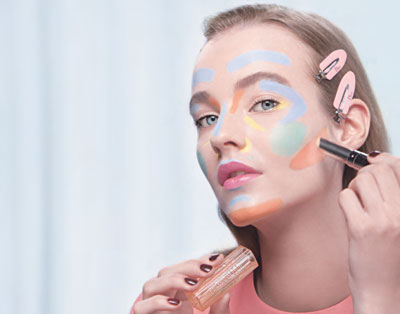All beauty aficionados are well aware that color correcting is a huge trend that has taken the beauty world by storm. HEALTH meets with Gilbert Soliz, Global Makeup Artist for Marc Jacobs Beauty to find out exactly how it’s done.
WHAT IT MEANS
According to Soliz, color correcting basically means neutralizing the skin using the power of color theory. He explains, “Color corrector can essentially be used by anyone who wishes to correct, even out, or perfect a range of cosmetic concerns from redness and discoloration to dullness. I love the versatility of use and color range from Marc Jacobs Beauty covert sticks – the shade range includes peach/orange for hyperpigmentation/discoloration, lime/citron for redness, and lilac/ lavender to combat dullness and brighten.”
TYPICAL SKIN PROBLEMS AND HOW TO CORRECT THEM
 Dark pigmentation around the upper lip area: Soliz suggests peach or orange. These tones of orange help disguise or lighten the look of deep pigmented areas. This works great especially on medium to deeper skin tones
Dark pigmentation around the upper lip area: Soliz suggests peach or orange. These tones of orange help disguise or lighten the look of deep pigmented areas. This works great especially on medium to deeper skin tones
DARK UNDER EYE CIRCLES:
Any form of orange. The lighter the skin is, the lighter the variation of orange should be. Peach, salmon, and orange are usually great tones from which to start, tells Soliz.
Redness/mild rosacea on the cheeks: Green, suggests Soliz, is very straightforward and very effective
UNEVEN SKIN TONE OVERALL:
Soliz says this really depends on the exact concern. To cover pimple marks or discoloration, he usually chooses green to help with the redness and peachy shades to help with darkness. For those with yellow undertones, lilac/ lavender can brighten the complexion nicely.
THE KEY
Prepping the skin is key and for this, Soliz explains, “A color corrector is applied before foundation/ concealer and should be applied in thin sheer layers with the finger tips or a complexion brush. ”
PERFECT SKIN TIPS
Remember, truly flawless skin is usually a sign of someone who has taken additional steps to even and perfect the skin, points out Soliz.
HERE ARE FEW MORE TIPS:
- Less is more.
- Start with sheer layers and gradually build.
- Use a synthetic brush to apply.
- Set with powder.


